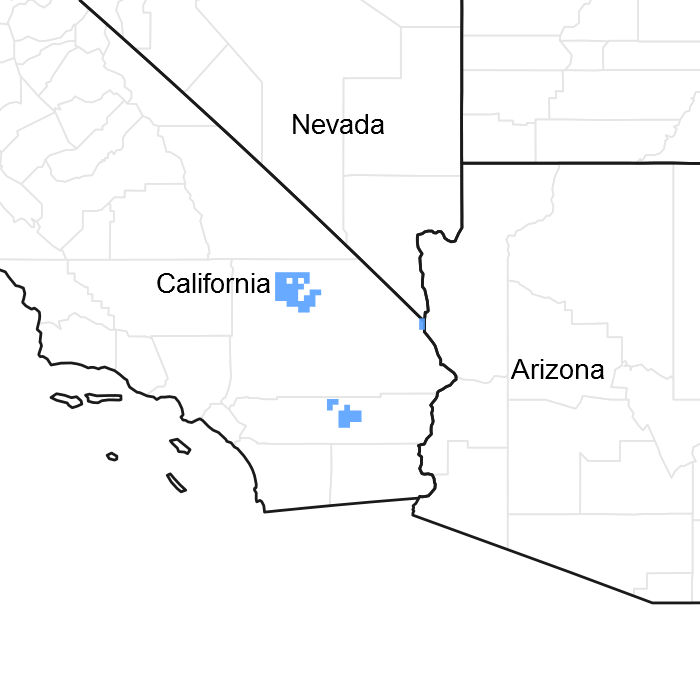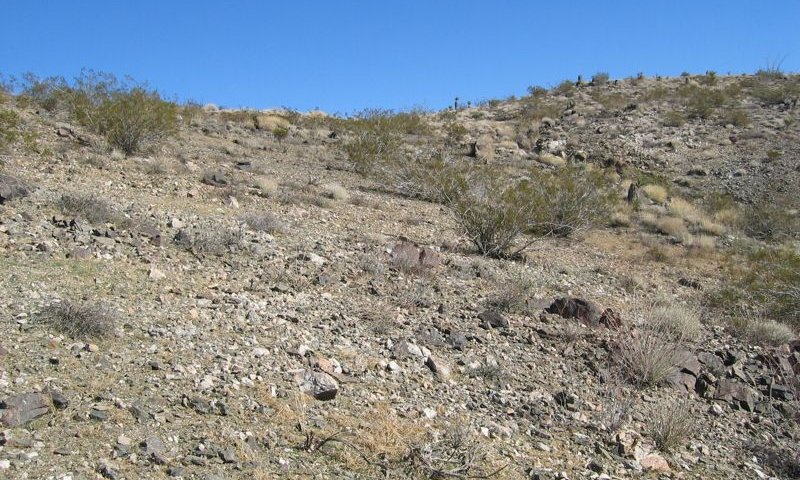

Natural Resources
Conservation Service
Ecological site R030XB139CA
Shallow Dry Hill 4-6 P.Z.
Last updated: 10/21/2024
Accessed: 12/21/2025
General information
Provisional. A provisional ecological site description has undergone quality control and quality assurance review. It contains a working state and transition model and enough information to identify the ecological site.

Figure 1. Mapped extent
Areas shown in blue indicate the maximum mapped extent of this ecological site. Other ecological sites likely occur within the highlighted areas. It is also possible for this ecological site to occur outside of highlighted areas if detailed soil survey has not been completed or recently updated.
MLRA notes
Major Land Resource Area (MLRA): 030X–Mojave Basin and Range
MLRA Description:
Major Land Resource Area (MLRA) 30, Mojave Desert, is found in southern California, southern Nevada, the extreme southwest corner of Utah and northwestern Arizona within the Basin and Range Province of the Intermontane Plateaus. The climate of the area is hot and dry with mostly hyperthermic and thermic soil temperature regimes and typic-aridic soil moisture regimes. Mean annual air temperatures are between 59-68 degrees F (15-20 C) with average summer maximum temperatures between 100-115 degrees F (38-46 C) and average winter minimum temperatures between 32-59 degrees F (0-15 C). This MLRA is within the arid climate zone however steep elevational gradients contribute to microclimates where semi-arid [mean annual precipitation is greater than 8 inches (200mm)] and hyper-arid [mean annual precipitation is less than 4 inches (100mm)] islands exist. Elevations range from below sea level to over 12,000 feet (3650 meters) in the higher mountain areas. Generally above 5,000 feet, soil temperature regimes can be mesic, cryic and frigid with soil moisture regimes being xeric or ustic. Orographic effects and low elevations can create hyper-arid conditions where the soil moisture regime is aridic-aridic. Due to the extreme elevational range found within this MLRA, land resource units (LRUs) were designated to group areas within the MLRA into similar land units.
LRU Description:
The arid climate zone (XB in ESD ID) LRU is found across the eastern half of California, much of the mid-elevations of Nevada, the southernmost portions of western Utah, and the mid-elevations of northwestern Arizona. Elevations range from 1800-5000 feet and precipitation ranges from 4-8 inches/year. Precipitation is bi-modal for most of the Mojave with precipitation occurring in winter and summer. Areas west of the 117 degree W meridian near Barstow, CA receive precipitation mainly during the winter months (Hereford et al. 2004). The soil temperature regimes are hyperthermic and thermic with a typic-aridic soil moisture regime. Vegetation includes creosote bush (Larrea tridentata), burrobush (Ambrosia dumosa), Mojave yucca (Yucca schidigera) Joshua tree (Yucca brevifolia), chollas, cactus, big galleta grass (Pleuraphis rigida) and several other warm season grasses. At the upper portions of the LRU, where the mean annual precipitation is between 6 to 8 inches (150-200 mm), plant production and diversity are greater and blackbrush (Coleogyne ramosissima) is a common dominant shrub.
Classification relationships
This ecological site is found within the Larrea tridentata Shrubland Alliance (Sawyer et al. 2009).
Ecological site concept
Colluvium and residuum derived from igneous and foliated metamorphosed material where soils are shallow and/or a shallow diagnostic horizon is present; South aspects between 2800 ft (850m) and 3525 ft (1075 m); all aspects below 2800 ft (850m).
This is a group concept and provisional STM that also covers R030XB017NV.
Associated sites
| R030XB077NV |
STEEP SOUTH SLOPE This ecological site occurs on adjacent south-facing slopes. Brittlebush (Encelia farinosa) is dominant. |
|---|---|
| R030XB172CA |
Warm Gravelly Shallow Hills This ecological site occurs on adjacent warm thermic slopes with a high percentage of large rock fragments. Creosote bush (Larrea tridentata) and Parish's goldeneye (Viguiera parishii) are co-dominant with a high diversity of secondary shrubs. |
| R030XB193CA |
Very Shallow To Moderately Deep Gravelly Slopes This ecological site occurs on adjacent slopes with an argillic horizon. Burrobush (Ambrosia dumosa), Nevada ephedra (Ephedra nevadensis), Parish's goldeneye (Viguiera parishii), jojoba (Simmondsia chinensis) and waterjacket (Lycium andersonii) are all important species. |
| R030XB140CA |
Shallow Hill 4-6" P.Z. This ecological site occurs on adjacent slopes with greater moisture availability. Burrobush (Ambrosia dumosa) and creosote bush (Larrea tridentata) are co-dominant. |
| R030XB156CA |
Limy 5-7" p.z. (Low Production) This ecological site occurs on adjacent fan aprons. Creosote bush (Larrea tridentata) and burrobush (Ambrosia dumosa) are dominant. |
| R030XB218CA |
Moderately Deep To Very Deep Loamy Fan Remnants This ecological site occurs on adjacent fan aprons. Burrobush (Ambrosia dumosa), Hall's shrubby spurge (Tetracoccus hallii), and creosote bush (Larrea tridentata) are dominant. |
| R030XB225CA |
Warm Sloping Pediments This ecological site occurs on adjacent dissected pediments. Hall's shrubby spurge (Tetracoccus hallii) and burrobush (Ambrosia dumosa) are dominant. |
| R030XY188CA |
Slightly Alkaline, Rarely To Occasionally Flooded Ephemeral Stream This ecological site occurs on adjacentn small ephemeral streams, and Hall's shrubby spurge (Tetracoccus hallii) and creosote bush (Larrea tridentata) are common. |
Similar sites
| R030XB193CA |
Very Shallow To Moderately Deep Gravelly Slopes This ecological site occurs on soils with an argillic horizon. Production is higher, and shrub diversity is higher, with burrobush (Ambrosia dumosa), Nevada ephedra (Ephedra nevadensis), Parish's goldeneye (Viguiera parishii), jojoba (Simmondsia chinensis) and waterjacket (Lycium andersonii) all important species. |
|---|---|
| R030XB017NV |
LIMY HILL 3-5 P.Z. This ecological site has lower production and diversity. |
| R030XD001CA |
Hyperthermic Dry Hills This ecological site occurs on slopes with a hyperthermic soil temperature regime. Shrub pecies composition is similar, but production is lower, and there is a negligible grass component. |
| R030XB140CA |
Shallow Hill 4-6" P.Z. This ecological site occurs on slopes with greater moisture availability. Production is higher, and burrobush (Ambrosia dumosa) is a dominant shrub. |
| R030XB146CA |
Volcanic Hill 5-7" P.Z. This ecological site occurs on slopes with volcanic parent material. Eastern Mojave buckwheat (Eriogonum fasciculatum) and burrobush (Ambrosia dumosa) are co-dominant. |
Table 1. Dominant plant species
| Tree |
Not specified |
|---|---|
| Shrub |
(1) Larrea tridentata |
| Herbaceous |
Not specified |
Click on box and path labels to scroll to the respective text.

